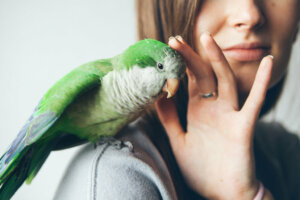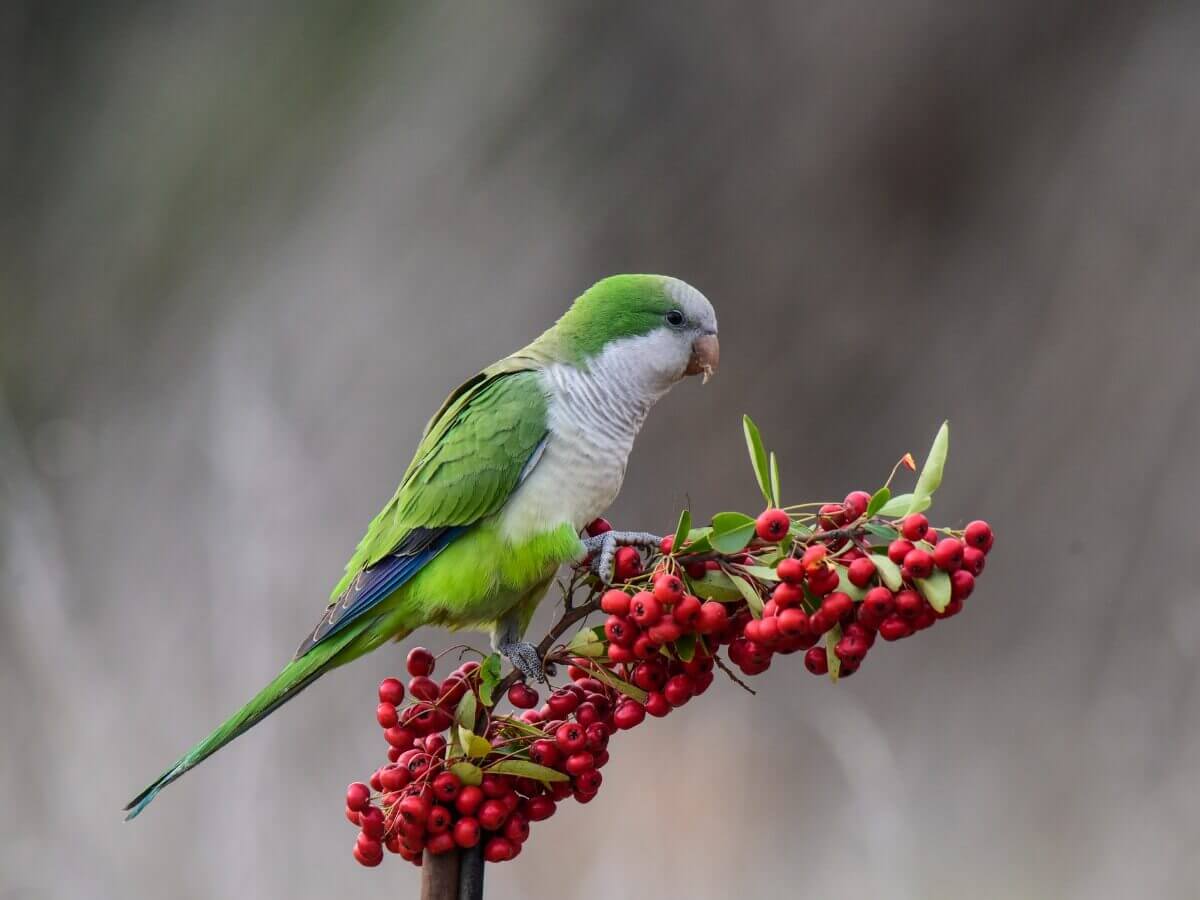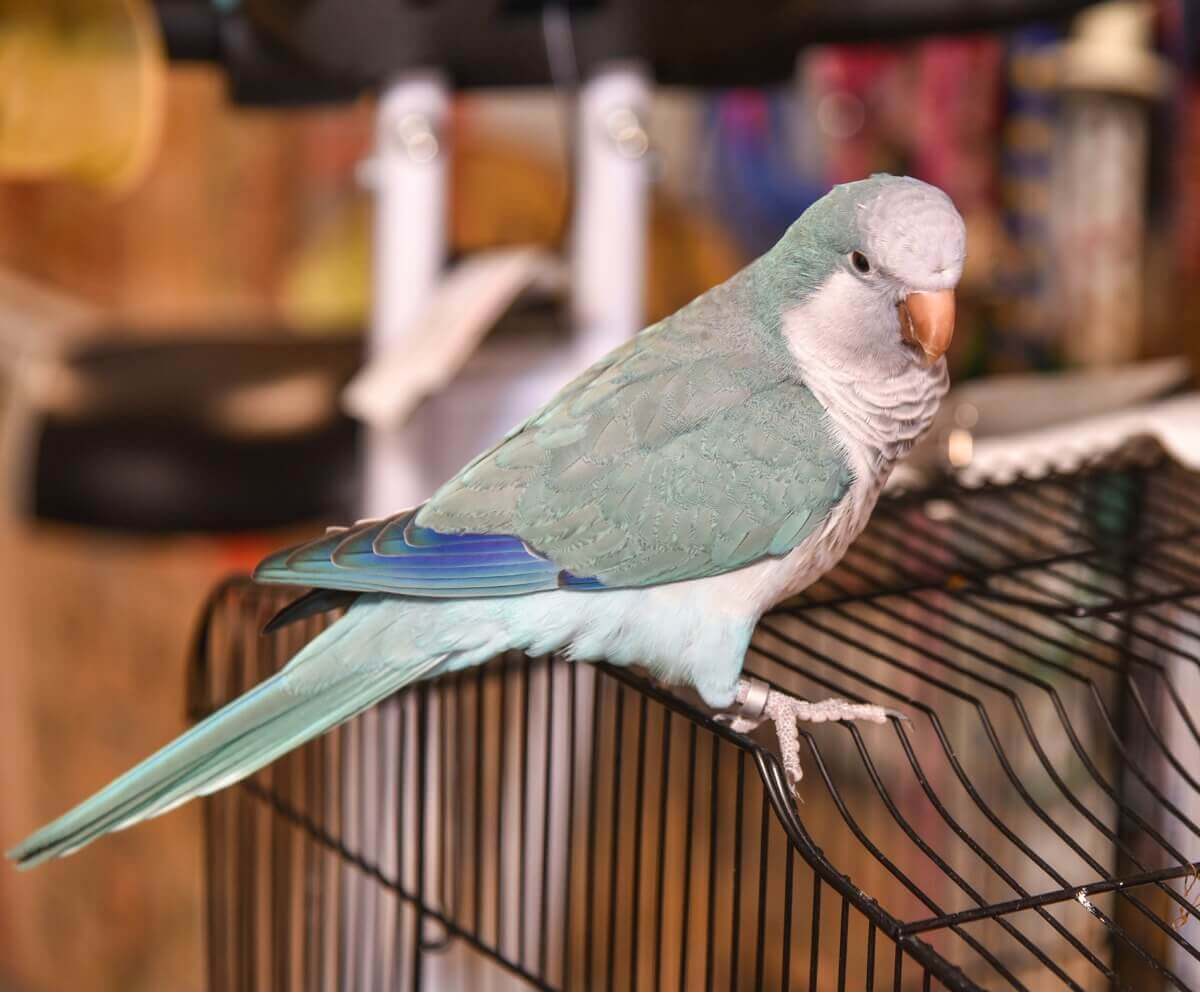10 Aspects of Monk Parakeet Care


Reviewed and approved by the biologist Samuel Sanchez
The monk parakeet (Myiopsitta monachus ), or the Quaker parrot, is a bird whose natural habitat is in Bolivia, Argentina, and southern Brazil, although its presence has spread far beyond these borders. The aspects that go into caring for a monk parakeet are many and varied, and all of them are of vital importance for the bird.
This bird belongs to the parrot family and stands out for its characteristic and mostly green color, for its intelligence, and for being known as one of the birds that makes the biggest scandals. This is a peculiarity that doesn’t please everyone, but it doesn’t stop being a beautiful animal that’s worth knowing about.
General characteristics of the monk parakeet
The monk parakeet or Quaker parrot measures about 12 inches and weighs about 5 ounces. It’s a bird that adapts easily to the environment, being able to subsist in urban areas together with other species. In the wild, it lives for about 10 years, but in captivity, it can reach 25-30 years.
Their feathers are green, with some yellow touches, and the front of the head, throat, and half of the chest are gray, in the case of young specimens. This one becomes a little lighter as the years go by, but the outer part of the wing feathers always remains a bright blue hue.
In addition to this, it’s worth highlighting its long tail that’s pointed and light green with small blue touches on the inside. Finally, its legs are gray, its strong beak is brown or brownish in color, and it has brown eyes.
Having clarified their main physical characteristics, we should mention that the distinction between female and male monk parrots is quite complicated and requires good observation. The only notable differences are that the male’s head is larger than that of the female and its upper jaw is also wider.

Caring for the monk parrot
Among the main aspects of monk parrot care, the management of its diet stands out But it’s not the only factor that owners need to take into account. Let’s look at some of the aspects that we must consider when caring for these birds.
1. Food
The monk parakeet is a granivorous bird, meaning that the basis of its diet is grain. Any type of whole grain that’s not refined is valid for it, but in specialized animal stores, you’ll easily find preparations that are made up of different types of grains that are mixed in a balanced way.
You can choose several of these preparations and alternate them in their diet, as it’s good to change the diet of these animals in order to encourage their appetite. In addition to this, you should occasionally offer them small portions of vegetables and fresh fruit and some insects, as they’re also part of their diet in the wild.
2. Cuttlebone and minerals
For the monk parakeet —as well as for the rest of birds—, having a cuttlebone is essential for many reasons. Pecking it will not only allow their beak to stay healthy by wearing it down and sharpening it, but the calcium they get will keep their bones strong and, in the event of laying eggs, the shells will be more consistent.
In addition to cuttlebones, you must also offer other types of minerals to the bird. These can be purchased in the pet stores themselves in the form of blocks and are special for birds. Its properties will make the bird stay healthier both internally and externally, which you’ll note, for example, in a brighter plumage.
3. The cage
One of the most important aspects of monk parrot care considering where it will live. This bird requires a large cage, with a minimum size of 40x20x20 centimeters in height, length, and width. Inside, there must be enough space to fly, in addition to perches at different heights so that they can perch on them.
The base of the cage must contain a mesh so that the parrot can’t access its own feces and become ill. In addition to this, you must take care of their environmental enrichment, putting at their disposal, for example, different toys for their mental stimulation. In addition, it must be easy for them to get to the food and water bowls – and the aforementioned cuttlebone.
Even so, it’s essential that the parrot be able to fly out of the cage for several hours a day. Therefore, it’s important to place it in a room where it can fly freely without danger. In addition to this, the temperature of the room must be warm, and the cage can never be located near drafts or where the sun’s rays fall directly.
4. Monk parakeets are gregarious birds
Monk parakeets are gregarious birds, meaning that they usually live in groups. Therefore, another aspect of monk parrot care to take into account is to consider the possibility of having a partner. Of course, at the same time, they’re somewhat territorial and jealous birds, so it’s best for the couple to live together from the beginning so that they adapt more easily.
5. A qualified veterinarian
If you choose an exotic bird for companionship, it’s essential to find a veterinarian who specializes in these types of animals. The monk parakeet will need at least one annual check-up, but it may be the case that it will need more visits and it’s best to bring it to a qualified professional for treatment.
Other care aspects and curious facts to take into account
Although the details we mentioned above are the main aspects of care, we’ll highlight other important insights.
6. Reproduction
If you decide to have a pair of male and female monk parrots and they get along, then they’re likely to bond for life. The months in which they go into heat are between August and November, and the female can lay between 4 and 8 eggs. Incubation lasts about 26 days.
After hatching, both parents care for the chicks until they’re strong and independent enough to leave the nest by 6 weeks. In the wild, the female would have built the nest before laying the eggs, normally in the highest branches of the trees.
7. Longevity
You should also take into account that they’re very long-lived animals, which can live up to 30 years. Therefore, by deciding to have one of these birds, you’re signing a long commitment. Unfortunately, not everyone wants to or can achieve this, and longevity is a very common reason for abandonment in this type of bird.
8. Cleaning the cage
Another aspect that goes into the care of the monk parakeets is the frequent cleaning of their cage. In addition to their feces, it’s very common to find food scraps, broken toys, and pieces of everything that may have passed through its beak, so you’ll have to spend a lot of time on the task of organizing the cage and keeping it in a good state of health.
9. Destructivity
Monk parakeets have a very strong beak, so they’re very good at breaking everything that’s within their reach. That’s why the materials of the elements that you offer them must be very resistant so that they don’t destroy them right away. As for the objects they play with and poke at with their beaks, you can also choose those that consist of natural materials, such as wood.
10. Objects within reach
Another interesting fact to keep in mind is that, whether you release them or if they escape —something they tend to have the least chance of— these birds love to get hold of small objects that they’ll use to form their nests. Be very careful not to leave coins, bracelets, and other precious goods within reach.
Is it legal to adopt a monk parakeet as a pet?
Before deciding to have an exotic animal as a pet, it’s very important to know what the law says about that specific species in the state or country where you live. For example, in the case of the monk parrot, in California, Connecticut, Georgia, Hawaii, Kentucky, Pennsylvania, Rhode Island, Tennessee, and Wyoming, keeping them as pets is totally prohibited. The same is true in Colorado, unless you’ve owned it since before 1990.
This is so because they lack natural predators, so their expansion is very simple and comes into conflict with the native fauna. Also, being grain-eating animals, parrots often rampage through cereal crops, wreaking havoc.
Their possession is also prohibited in more than a dozen states in the US. This decision was reached after many of these parrots were introduced as pets into homes between the 1960s and 1980s, which later escaped or were intentionally released. This allowed its proliferation to the point of becoming an invasive pest.
Another similar case is that of Chile, where the monk parrot was also marketed as a pet and its abandonment in the wild allowed its indiscriminate reproduction. Today, Chile considers it to be a pest and is very dangerous for ecosystems and native species, as it endangers other parrots in the country.

Final recommendation
In addition to confirming the legal possibility of having one at home and the care that you should provide, you must remember that, although monk parrots are very friendly with people and are very intelligent, those who adopt one must remain patient and consistent.
This is an animal that can be very noisy, somewhat mischievous, and destructive, and these characteristics are, in many cases, those that have caused and continue to cause the abandonment of this species, with all its negative consequences. If you want to have a monk parrot, educate yourself well and talk with experienced owners before making a decision.
All cited sources were thoroughly reviewed by our team to ensure their quality, reliability, currency, and validity. The bibliography of this article was considered reliable and of academic or scientific accuracy.
- Myiopsitta monachus. Recogido el 10 de julio en https://es.wikipedia.org/wiki/Myiopsitta_monachus#En_Espa%C3%B1a
- Grupo de aves exóticas. Sociedad Española de Ornitología. Recogido el 10 de julio en https://seo.org/wp-content/uploads/2013/05/fichagae_myiops_monachus_2005.pdf
- Cotorra argentina. Recogido el 10 de julio en https://seo.org/ave/cotorra-argentina/
- Martín, M. (2006). La cotorra argentina (Myiopsitta monachus) en la ciudad de Madrid: expansión y hábitos de nidificación. Anuario Ornitológico de Madrid, 2005, 76-95.
- Almansa, G. M. D. C. (2017). MANUAL AVES EXÓTICAS LOROS DIAMANTES AGAPOPORNIS PERIQUITOS COTORRAS GUACAMAYOS LORIS CACATUAS . . .: MANUAL CUIDADOS AVES EXÓTICAS (Spanish Edition). Independently published.
This text is provided for informational purposes only and does not replace consultation with a professional. If in doubt, consult your specialist.